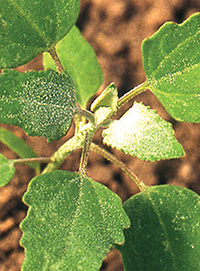 Common lambsquarters, or lambsquarters, is an early emerging summer annual weed that is prevalent in the Midwest. Herbicide-resistant populations have been found in several states. According to Michigan State University, lambsquarters can cause up to 13% yield loss in corn and up to 25% yield loss in soybeans.
Common lambsquarters, or lambsquarters, is an early emerging summer annual weed that is prevalent in the Midwest. Herbicide-resistant populations have been found in several states. According to Michigan State University, lambsquarters can cause up to 13% yield loss in corn and up to 25% yield loss in soybeans.
- Common names: Common lambsquarters, lambsquarters, white goosefoot
- Scientific name: Chenopodium album L.
- Cotyledons: Two, linear cotyledons on seedlings
- Leaf shape: Triangle-shaped with toothed margins and white, grainy surface on mature plants
- Stems: Vary in color from green to reddish, smooth and grooved in texture
- Reproduction: Monoecious (having male and female attributes on the same plant)
- Flowers: Small, gray-green flowers clustered at stem tips
Fast facts
- Common lambsquarters is one of the earliest-emerging summer annual weeds. About 25% of the plants emerge prior to spring burndown applications or tillage. Peak emergence occurs in mid- to late-spring with seeding typically in late summer into fall.1
- Lambsquarters grows quickly, with mature plants reaching up to 5 feet tall in the right conditions.
- The average lambsquarters plant produces about 72,500 seeds, with some producing up to 176,000 seeds.2
- Lambsquarters seeds are some of the most persistent in the soil. It can take up to 78 years to reduce the seedbank by 99%.1
- Because lambsquarters grows so quickly and produces so many seeds, it’s one of the most competitive weeds in Midwest fields. It’s particularly competitive with soybeans given how tall plants can get. Lambsquarters can reduce soybean yield by 25% with less than one weed per foot of row and can reduce corn yield by 13% with one weed per 1.5 feet of row.2
- According to WeedScience.org, herbicide-resistant lambquarters has been found in 22 states.
- The weed has formed resistance to Photosystem II inhibitors (Group 5 herbicides) and ALS inhibitors (Group 2 herbicides) in the United States.
Control tips
- A weed control program approach using burndown, preemergence and postemergence herbicides with multiple modes of action and residual activity can help keep lambsquarters under control.
- It is more difficult to suppress lambsquarters with postemergence herbicides, so it’s important to use a full program approach in your customers’ fields.2
- In soybeans, you can use Elevore® herbicide as a burndown, followed by a preemergence application of Sonic® herbicide and then a postemergence application of Synchrony® XP herbicide.
- In corn, you can use Basis® Blend herbicide as a burndown, followed by a preemergence application of SureStart® II herbicide and then a postemergence application of Resicore® herbicide.
- Farmers can also use cultural practices to help control lambsquarters:2
- Tillage, particularly dark tillage, or tilling at night, can suppress emergence by 30 to 70%. Because of this, late planting may help control the weed to allow time to till in spring.
- Rotary hoeing can control lambsquarters when it’s under ¼ inch tall.
- Including small grains in crop rotation can keep the weed at bay
1United Soybean Board. 2021. Common Lambsquarters. https://iwilltakeaction.com/weed/common-lambsquarter
2Michigan State University. Common Lambsquarters. https://www.canr.msu.edu/weeds/extension/common-lambsquarters
Basis® Blend, Elevore®, Sonic®, Realm® Q, Resicore®, SureStart® II and Synchrony® XP are not registered for sale or use in all states. Resicore and SureStart II are not available for sale, distribution or use in Nassau and Suffolk counties in the state of New York. Contact your state pesticide regulatory agency to determine if a product is registered for sale or use in your state. Always read and follow label directions.
